Choosing between modern and traditional design styles is more than following trends. It’s about creating a space that truly reflects who you are. Let’s dive into modern vs traditional styles and how these styles impact your home’s atmosphere, functionality, and even your daily routine.
Modern design is often seen as stark whites and open layouts. Traditional design, on the other hand, is thought to be about stuffy velvet sofas. But, let’s debunk these myths!
Key Takeaways
- Modern design’s clean lines and open layouts contrast traditional’s layered textures and historical details.
- Materials matter: From brick to stone, versatile options like Slimbrick® let you mix styles seamlessly.
- Modern spaces prioritize functionality and sustainability, while traditional designs celebrate craftsmanship and heritage.
- A transitional blend—think mid-century furniture with floral upholstery—creates harmony between old and new.
- Understanding color palettes (neutral neutrals vs warm tones) unlocks your style’s emotional impact.
Understanding Modern vs Traditional Design Styles
Choosing between modern or traditional design is more than just aesthetics. It’s about the atmosphere you desire in your home. Let’s explore the essence of contemporary design and how current design trends shape these decisions.
Modern design is a philosophy, not just a fleeting trend. It’s characterized by open layouts, geometric forms, and smooth surfaces. Picture a living room with expansive windows, a minimalist sofa, and tech-enabled storage. Traditional design, on the other hand, offers warmth through detailed woodwork, plush fabrics, and balanced layouts. Envision a dining room with a gleaming mahogany table and plush chairs.
Defining Modern Design
- Clean lines and uncluttered spaces
- Focus on functionality and open layouts
- Materials like glass, steel, and concrete
- Neutral palettes with pops of bold color
“Less is more”—a mantra Ludwig Mies van der Rohe coined that shapes modern spaces today.
Defining Traditional Design
- Ornate woodwork and detailed moldings
- Symmetrical arrangements and heirloom-quality furniture
- Rich materials like marble and silk
- Warm, layered color schemes with gold or jewel tones
The Fundamental Differences
Modern design champions innovation, with smart storage and eco-friendly materials. Traditional design, in contrast, celebrates heritage, with antique pieces and handcrafted furniture. Yet, the beauty lies in their fusion. Combining a modern console table with a vintage rug or a mid-century chair with floral wallpaper creates something extraordinary.
The Historical Evolution of Design Aesthetics
Ever ponder the link between today’s design trends and the past? Let’s explore how classic design principles evolved into the timeless foundations we cherish. Styles like Baroque and Victorian, with their ornate mirrors and gilded frames, were once symbols of wealth and craftsmanship. On the other hand, modern design emerged as a counter-movement, focusing on function over form.
| Style | Time Period | Influence |
|---|---|---|
| Arts & Crafts | 1850–1920 | Revolt against industrialization, handcrafted details |
| Bauhaus | 1919–1933 | “Form follows function”—minimalism meets technology |
| MCM (Mid-Century) | 1935–1975 | Clean lines + organic shapes = timeless appeal |
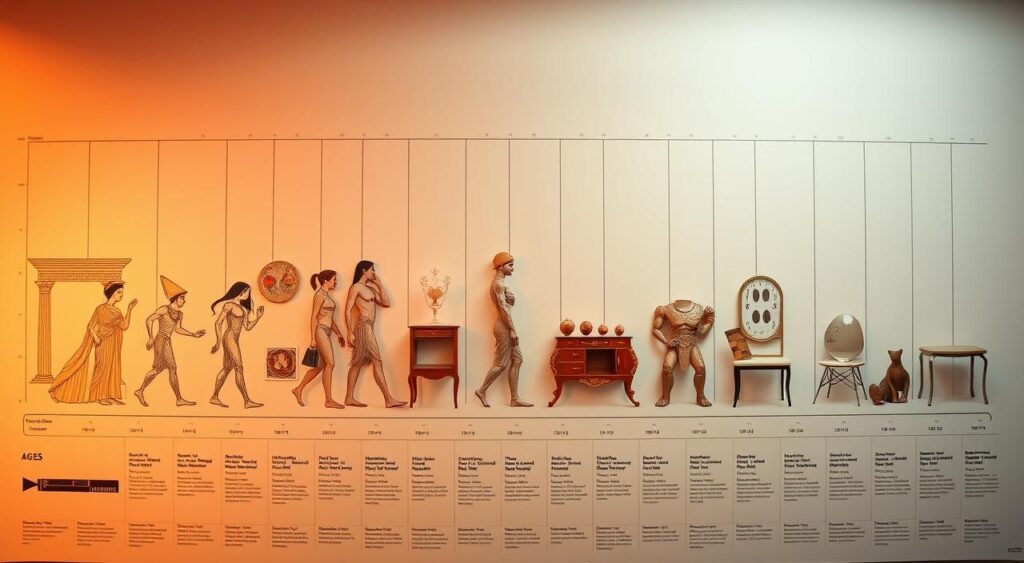
Timeless design transcends mere trends, embracing both past and present. Scandinavian modern, for instance, combines rustic woods with sleek lines, creating a classic yet contemporary look. Postmodernism’s eclecticism also demonstrates how modern styles draw from classic motifs. Remember, each era’s innovations become the next’s inspiration. As Bauhaus founder Walter Gropius noted, “The artist is a natural builder.” By blending these influences, your space can reflect history without being bound by it. Are you ready to blend eras and create your unique space?
Key Characteristics That Define Modern Design
Modern interior design transcends mere trends, embodying a profound philosophy. It’s about eliminating the extraneous to unveil spaces that are both functional and motivating. Let’s explore what makes modern interior design truly memorable.
Clean Lines and Minimalism
- Sharp angles and uncluttered layouts, inspired by visionaries like Le Corbusier
- Decor with open spaces—like floating shelves or hidden storage—brings visual serenity
- Mid-century modern pieces (like Eames chairs) serve as the cornerstone of minimalist aesthetics
Material Innovation
| Material | Modern Use |
|---|---|
| Steel | Exposed beams or frameless glass partitions |
| Concrete | Textured accent walls or sleek countertops |
| Reclaimed Wood | Warm contrasts with industrial metals |
These materials harmonize contemporary design with eco-consciousness—consider eco-friendly bamboo floors or recycled metal accents.
Focus on Function and Form
Every piece serves a purpose! Sleek sofas function as storage, while built-in nooks optimize small spaces. Decorative items, like pendant lights, also serve as functional art.
Color Palettes in Modern Spaces
Neutral bases (white, charcoal, linen) allow bold accents to stand out. A cobalt blue accent wall or a mustard-yellow throw pillow can instantly energize a space!
Ready to transform your space? Modern design is about making intentional choices that turn your home into a sanctuary of style. Let’s dive into creativity!
Essential Elements of Traditional Design
Imagine stepping into a room where every detail speaks of craftsmanship and heritage. Traditional home decor is more than fleeting trends; it’s a celebration of enduring elegance. Let’s explore what makes classic design both inviting and majestic.
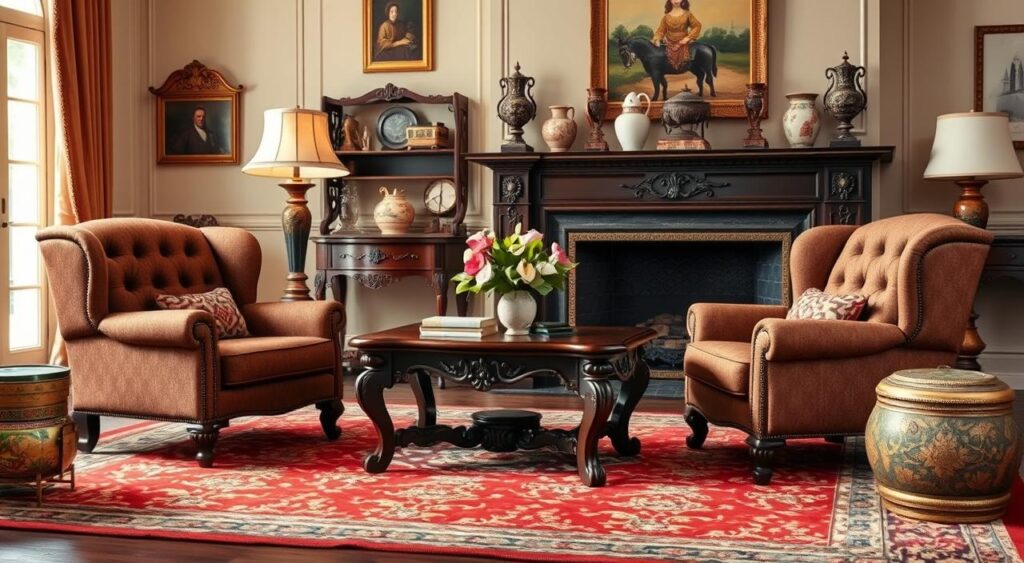
Picture a space where every element is chosen with purpose. Here’s how to achieve that classic feel:
Ornate Details and Craftsmanship
- Crown molding, wainscoting, and carved woodwork add texture and depth
- Antique-inspired fixtures and detailed trim work showcase artisan skill
Time-Honored Materials
Consider materials that mature with grace:
- Hardwoods like oak and mahogany
- Velvet, damask, and silk upholstery
- Brass hardware and marble accents
Symmetry and Balance
Traditional spaces rely on harmony. Picture:
- Matching side tables flanking a sofa
- Centered chandeliers above dining tables
- Paired decorative vases on mantles
Rich Color Schemes and Patterns
Warmth meets luxury with:
- Deep burgundy, navy, and forest green hues
- Floral, plaid, and damask patterns layered thoughtfully
| Classic Design Element | Modern Twist |
|---|---|
| Antique furniture | Modern upholstery fabrics |
| Gold trim | Sleek hardware finishes |
Want to try this style? Mix a velvet sofa with sleek modern lighting for balance. Traditional home decor isn’t about rigidity—it’s about honoring history while making spaces your own. Ready to add a touch of timeless elegance?
Modern vs Traditional Architecture: Structural Differences
Ever wondered how a home’s bones shape its vibe? Let’s explore the modern vs traditional architecture through their physical structures. Modern designs focus on open floor plans with sleek lines, embodying modern vs traditional design styles that value flow over formality. Traditional homes, on the other hand, feature compartmentalized rooms and symmetrical layouts, drawing from historical precedents.
| Aspect | Modern Architecture | Traditional Architecture |
|---|---|---|
| Materials | Glass, steel, concrete | Wood, brick, stone |
| Rooftops | Flat or low-pitched roofs | Pitched roofs with dormers |
| Layout | Open-concept spaces | Separate, defined rooms |
| Details | Cantilevers, minimalist moldings | Ornate moldings, columns, arches |
Consider how materials affect sustainability. Modern homes use steel and concrete, allowing for innovative designs like floating staircases. Yet, they require more maintenance. Traditional homes, built with natural materials like terracotta or brick, have proven durability and aesthetic appeal. Modern kitchens blend seamlessly with living areas, reflecting a lifestyle emphasis. Traditional homes, by contrast, maintain distinct room functions, such as formal dining areas that command attention.
- Modern: Prioritizes functionality over ornamentation
- Traditional: Uses historical motifs as design anchors
- Both styles use light differently—modern maximizes windows, traditional layers with drapes
Choosing between these styles is more than a matter of aesthetics; it’s about how you want to interact with your space. Are you ready to make a decision? Let’s explore further in the next section!
Furniture Selection: Modern vs Traditional Approaches
Deciding between modern vs traditional furniture hinges on your lifestyle and aesthetic preferences. Modern designs emphasize sleek lines and innovation. In contrast, traditional pieces highlight craftsmanship and heritage. Let’s explore what makes each style distinct and how they can harmonize.
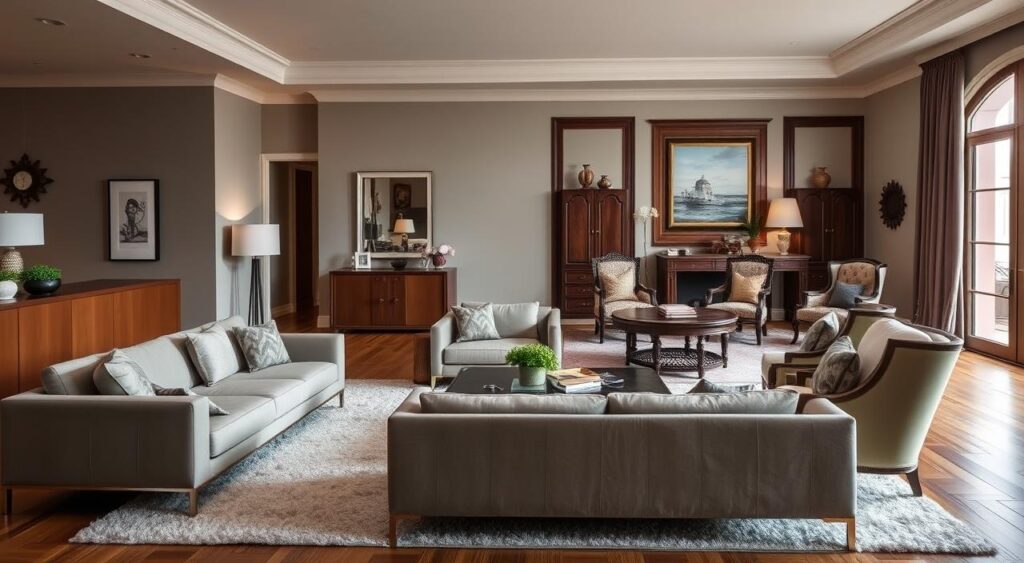
| Modern Furniture | Traditional Furniture |
|---|---|
| Clean lines, glass/metal accents | Carved wood, ornate detailing |
| Neutral tones with bold accents | Rich colors, floral/leather upholstery |
| Multi-functional storage solutions | Heavy, statement-making silhouettes |
Modern Furniture Characteristics
- Consider contemporary design with minimalist forms—like the Tate Champagne Silver Bed’s sleek platform base
- Materials such as steel, acrylic, and engineered wood contribute to an airy feel
- Hidden storage in coffee tables or beds optimizes small spaces
Traditional Furniture Staples
- Seek out clawed feet, cabriole legs, and hand-carved details like the Valantino Loft Sofa
- Velvet upholstery and mahogany finishes add classic elegance
- Symmetrical layouts and heirloom-quality pieces create enduring appeal
Investment Value Comparison
Modern designer pieces from brands like Eames or Knoll often gain collectible status over time. Traditional antiques appreciate steadily, thanks to solid woods like mahogany. Consider: Do you prefer a contemporary design that evolves with trends, or a timeless collection to pass down?
Regardless of your choice, let your furniture tell your story. Mixing a mid-century coffee table with a wingback chair is perfectly fine. Your space should reflect your personality, not just follow rules.
Color Theory and Application Across Both Styles
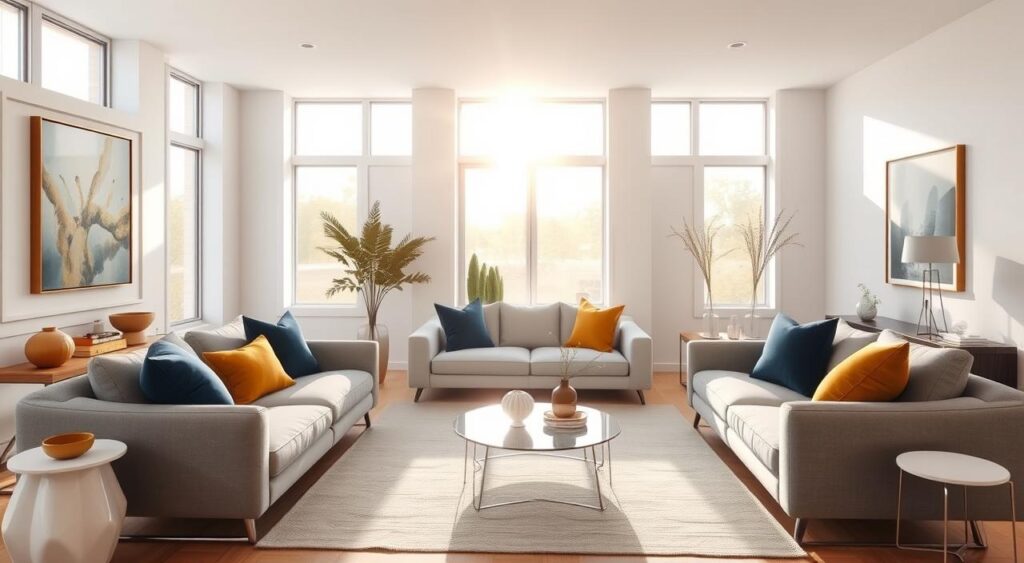
Ever ponder the impact of color in a room? Let’s dissect the modern interior design and traditional home decor color schemes. Begin with neutrals as your base—whites for modern or warm creams for traditional. For bold accents, consider cobalt blue vases on a minimalist shelf or a ruby-red sofa in a formal living room.
| Style | Core Colors | Key Applications |
|---|---|---|
| Modern | Neutrals + bold primary accents | Statement furniture, geometric art |
| Traditional | Rich jewel tones + warm neutrals | Textured fabrics, floral arrangements |
Modern Palette Play
Explore mid-century modern with teal accents or Scandinavian-inspired gray walls. Adhere to the 60-30-10 rule: 60% neutral, 30% secondary, 10% accent. Monochromatic schemes with varying shades of a single color are also effective.
Traditional’s Warmth Advantage
Traditional spaces excel with burgundy dining chairs or gold-trimmed mirrors. Jewel tones like emerald green add opulence. Pair damask-patterned wallpapers with complementary hues for layered sophistication.
Mixing Both Worlds
Mixing styles? Use a navy accent wall (traditional) in a modern loft or add a geometric rug to a classic living room. Warm colors energize social zones, while cool tones calm bedrooms. Test hues with paint swatches before committing!
Color is your canvas—treat your space as your personal art gallery. Experiment, mix, and match until it feels like home!
Accessorizing Your Space: Modern vs Traditional Décor
Accessorizing is where your style comes alive! Modern spaces thrive on timeless design elements that make a bold statement without clutter. Think sleek sculptures, geometric vases, or a single striking artwork—items that speak volumes with minimal fuss. Traditional décor leans into heirlooms, textured throws, and patterned pillows that tell stories through layers. Both styles can coexist beautifully when you balance their vibes.
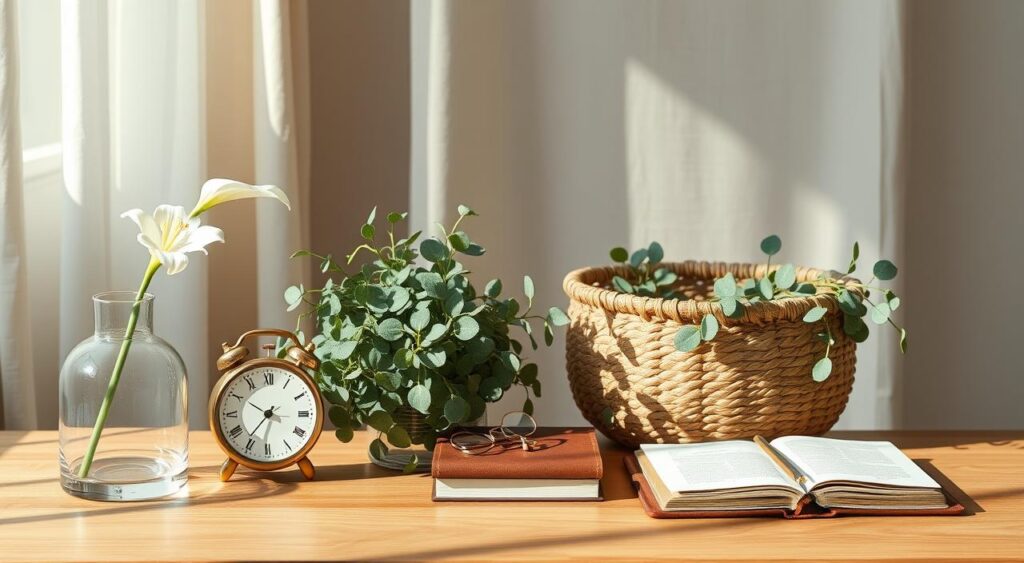
- Modern: Opt for glass, metal, or acrylic pieces. A sculptural floor lamp or abstract wall art adds instant sophistication.
- Traditional: Layer in velvet throws, embroidered linens, and decorative boxes. Group small collectibles like porcelain figurines or vintage books to create cozy vignettes.
- Mix ‘n’ match: Blend both with transitional textiles—think a sleek sofa in a classic fabric like chenille. Swap out seasonal pillows to follow current design trends without overhauling your setup.
Let’s say you love modern clean lines but crave warmth. Try a leather-bound journal on a glass-top table—it’s a nod to both eras! Swap in a woven rattan tray or a geometric ceramic planter to bridge gaps. The goal? Choose pieces that resonate with YOU. A vintage clock on a minimalist shelf? That’s the perfect conversation starter!
Remember: Accessories are your creative playground. Mix, layer, and let your choices reflect your life story. Whether it’s a hand-painted vase from your travels or a futuristic lamp, every object tells a tale. So go ahead—turn your space into a reflection of your unique journey!
Regional Design Preferences Across America
Ever wondered how where you live shapes your home’s style? Let me break down current design trends that mix modern vs traditional design styles across the U.S.!
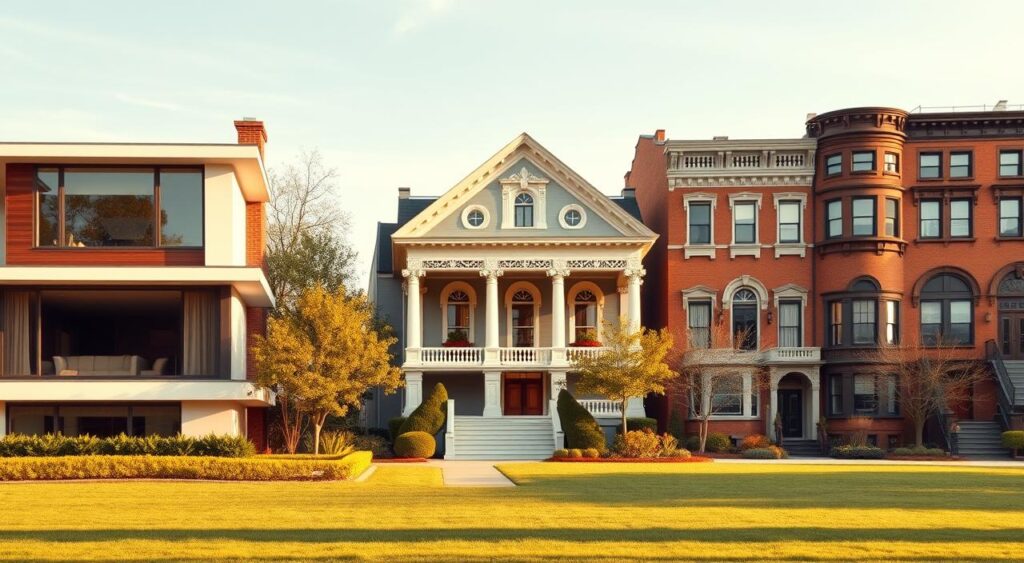
Coastal Modern vs Southern Traditional
In California and Florida, coastal modern spaces thrive with bleached woods and ocean-inspired palettes. In contrast, Southern Traditional designs focus on heirloom pieces and grand porches. The Southwestern trend features Adobe homes with terracotta accents. These styles aren’t just about looks—they connect you to your location.
Urban vs Rural Design Tendencies
- Urban areas like Chicago or Seattle favor sleek modern layouts with industrial materials.
- Rural homeowners often choose farmhouse or Craftsman styles, blending wood accents and open spaces.
Regional Materials and Influences
Materials tell a story. The Northeast’s Cape Cods use weathered blue wood, while the Midwest’s Prairie homes embrace horizontal lines. Out West, stucco and red-tile roofs nod to Mediterranean roots. Each region’s climate and history shape what feels “home” there.
“Mixing styles like Coastal Modern with a touch of Southern charm makes spaces timeless.” – Interior Designer, New Orleans
Want to try this? Start with your region’s signature materials—like desert tones in Arizona or nautical elements in Maine. Small touches like a terracotta vase or reclaimed wood can tie you to your roots while feeling fresh!
Creating a Transitional Style: Blending Modern and Traditional Elements
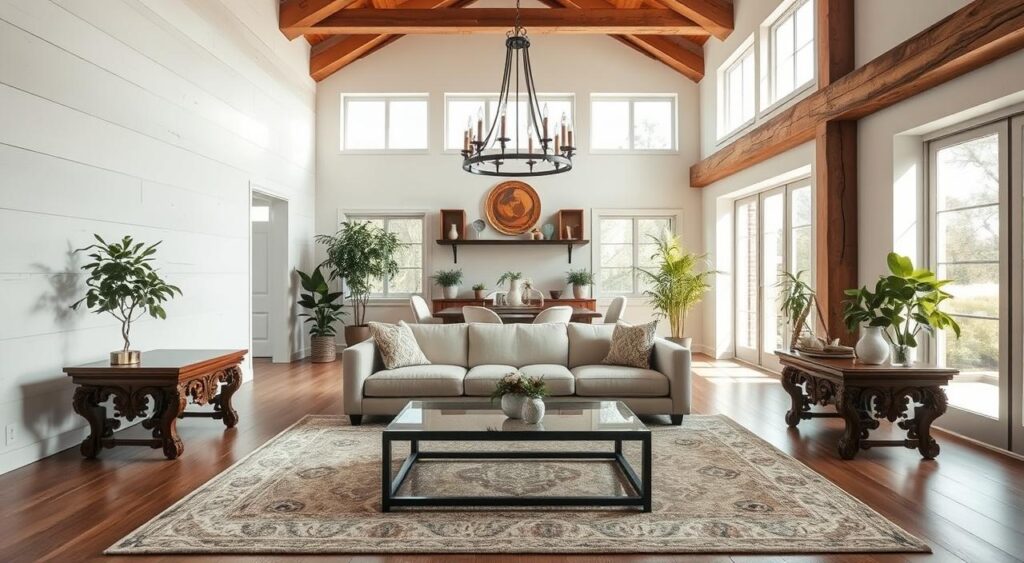
Choosing between modern and traditional styles can be tough. Transitional design offers a solution by combining the best of both. It creates spaces that are both timeless design and warm, yet sleek and classic. We’ll look at how to balance these styles without losing your personal touch.
Blending Old and New Made Simple
- Pair sleek modern furniture with carved wood accents
- Use neutral palettes (whites, grays) as a foundation
- Layer textures like linen, velvet, and natural wood
- Add metallic accents (brass, gold) for modern contrast
- Use open layouts with classic molding details
Real-Life Transitional Designs
| Space | Modern Elements | Traditional Elements |
|---|---|---|
| Kitchen | Sleek hardware, quartz countertops | Curved hoods, decorative moldings |
| Bathroom | Geometric tiles, matte black fixtures | Floral wallpapers, marble vanities |
| Living Room | Low-profile sofas, glass coffee tables | Antique-style chandeliers, tufted chairs |
Room-by-Room Mixing Tips
In kitchens, swap ornate handles for minimalist pulls while keeping modern vs traditional design comparison cabinetry shapes. Bathrooms can pair subway tiles with gold sconces. Bedrooms work best with tailored headboards and geometric area rugs. Every room needs a neutral base to let contrasting elements shine.
Remember: 18% of homeowners now choose transitional design for its adaptability. Whether you’re updating a mantel or choosing lighting, let function and personal taste guide your choices. Mixing is about creating a home that evolves with you—without looking dated.
Budget Considerations: Cost Comparison Between Styles
Let’s dive into the numbers! Modern interior design often focuses on affordability. It features clean lines and minimal decor, which means fewer items to purchase. Think sleek sofas or modular storage. On the other hand, traditional home decor can be more expensive due to carved moldings, silk drapes, or hand-painted wallpapers. But, there are smart ways to manage your budget.
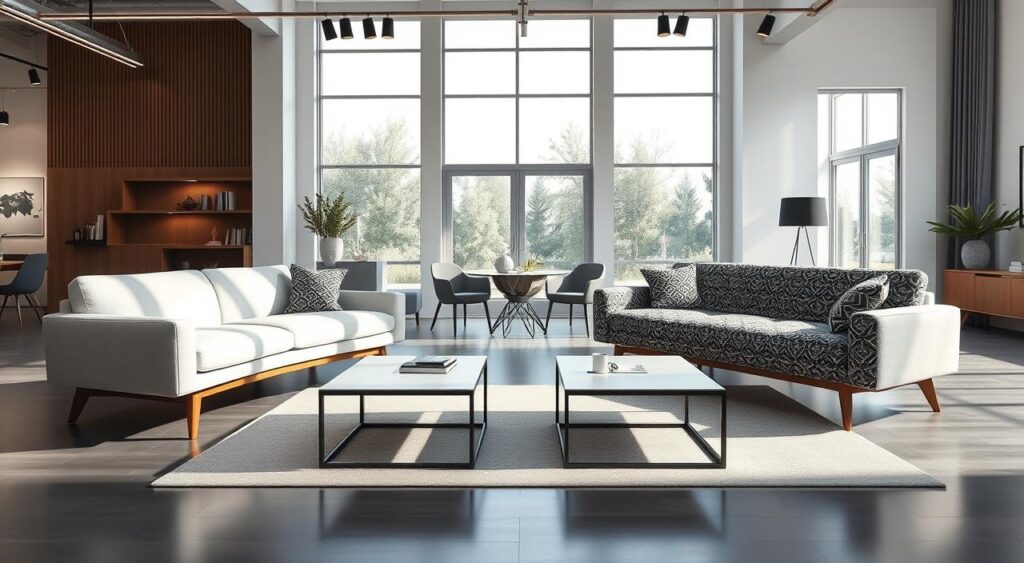
| Factor | Modern Interior Design | Traditional Home Decor |
|---|---|---|
| Furniture Cost | $500–$2,000 for modular pieces | $1,500–$5,000+ for carved wood or velvet upholstery |
| Paint & Materials | Flat white paint ($20–$50/gallon) for seamless walls | Gold leaf accents or custom murals (up to $200/sq ft) |
| Longevity | Easier to refresh with new decor | Antiques hold value over decades |
Here’s how to save without sacrificing style:
- Swap out trim colors: Black trim adds modern edge; white trim keeps it timeless—all for $50 a gallon!
- Use sliding barn doors ($150–$400) instead of custom pocket doors for modern spaces
- Shop thrift stores for ornate lamps or mirrors to add traditional flair affordably
Remember, hiring a designer doesn’t have to break the bank. Online consultations start at $79, and hourly rates average $100–$200. Need help? I recommend Wayfair or IKEA for budget-friendly modern pieces, while Pottery Barn offers traditional classics at mixed price points. Mixing styles? Try these tricks:
“Layer a sleek sofa under a traditional chandelier—it’s drama on a dime!”
Stick to the 80/20 rule: Invest 80% of your budget in timeless pieces, then splurge 20% on bold accessories. With these strategies, you’ll achieve the look you love without overspending. Ready to transform your space? Let’s get creative—without the sticker shock!
How to Determine Which Style Truly Fits Your Lifestyle
Choosing between modern and traditional design starts with understanding your daily life. Ask yourself: do you crave simplicity and innovation or comfort in timeless elegance? Let’s break it down so you pick a style that feels like home.
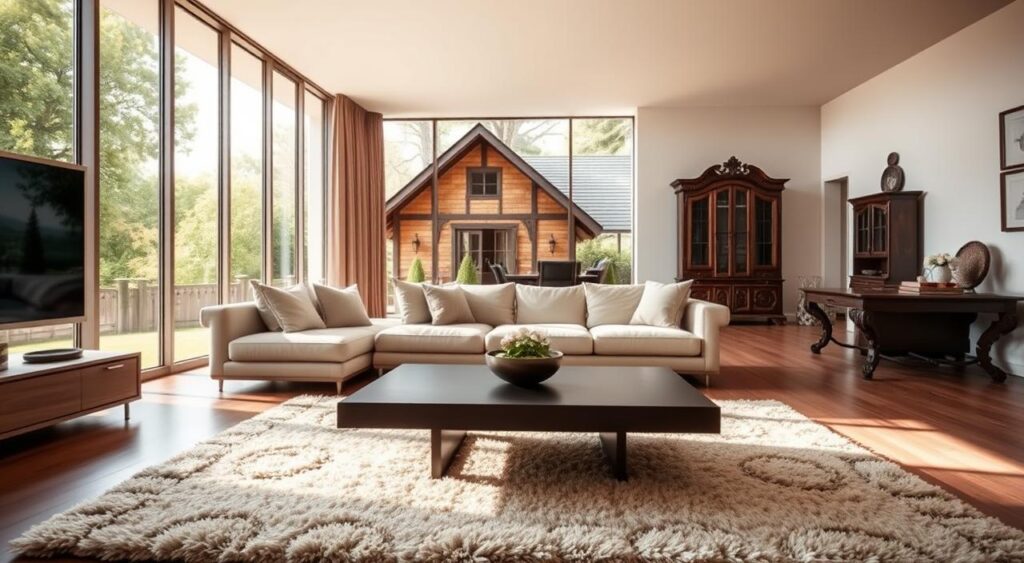
Personality Assessment: Your Style Mirror
Reflect on your preferences. Modern style’s clean lines and minimal decor resonate with those who value current design trends like open layouts and eco-friendly materials. Traditional’s rich textures and classic patterns—think velvet upholstery or carved wood—appeal to those who cherish heritage aesthetics. Which speaks to your heart?
Practical Lifestyle Checkup
Consider daily routines. Modern’s sleek surfaces work well for small spaces and low-maintenance living. Traditional’s heirloom-quality pieces suit those who entertain formally or want statement pieces that age gracefully. Ask: does your life thrive in symmetry and detail or crave flexibility?
| Lifestyle Factor | Modern Style | Traditional Style |
|---|---|---|
| Entertaining | Open layouts for casual gatherings | Formal dining areas and grand entryways |
| Maintenance | Low-maintenance materials (glass, steel) | Rich fabrics and wood require regular care |
| Longevity | Minimalist trends stay relevant longer | Classic elements never go out of style |
Lasting Happiness: Beyond Trends
Think ahead: Will modern’s bold contrasts or traditional’s heirloom details bring joy over years? Mix both if needed—many homeowners blend styles to balance aesthetics and function. Need help? Our experts can guide your choices so your space grows with you!
Conclusion: Embracing Your Design Identity
Your exploration of modern vs traditional design styles has shown how each style can create spaces that truly reflect who you are. Timeless design is not about picking one style over the other. It’s about creating a home that reflects your life, values, and dreams. Whether you prefer modern’s clean lines or traditional’s deep heritage, every choice has a story to tell.
Mixing styles can lead to something uniquely yours. Think about combining modern simplicity with Art Deco’s vibrant geometric patterns. For inspiration, check out modern vs traditional design styles. Pieces like Laskasas’ Foster Sofa or Marlow Armchair allow you to blend cultural motifs with today’s comfort. Even small touches, like adding traditional textiles to modern furniture, can bridge different eras.
Interior design is at its best when it mirrors your personality. If modern’s open layouts appeal to you, go for it. If you love heirloom furniture, make it a part of your space. Experts like Gatz Construction in Dowagiac, Michigan, excel at balancing these choices. They turn your vision into a space that feels like an extension of you.
There’s no one-size-fits-all approach here. Whether you’re drawn to minimalism or maximalism, let your choices reflect your lifestyle. Trust your instincts—your ideal design is more than a style; it’s a celebration of your home. Start small, experiment, and let every detail tell your story.
FAQ
What defines modern design?
Modern design is marked by simplicity and functionality. It features clean lines and minimal ornamentation. Open floor plans and large windows are common, creating airy, uncluttered spaces.
How is traditional design different from modern design?
Traditional design draws from 18th and 19th-century European décor. It showcases ornate details, symmetry, and classic silhouettes. This style emphasizes craftsmanship and warmth, often using rich colors and layered textures.
Can I mix modern and traditional elements in my home?
Absolutely! Many homeowners blend modern and traditional styles for a unique look. This approach creates spaces that feel both fresh and timeless, thanks to thoughtful balance.
What are some current design trends in modern and traditional styles?
Modern design trends include sustainable materials and bold colors against neutral backgrounds. Traditional design sees a resurgence of vintage elements and a focus on handcrafted details, celebrating artisanal skills.
How do budget considerations impact my choice between modern and traditional design?
Both styles can fit various budgets. Modern design might require fewer, more impactful pieces. Traditional furniture, with its detailed craftsmanship, can be more expensive. Plan your design carefully, balancing where to invest and save.
How can I effectively transition between modern and traditional color schemes?
Blend styles by using a traditional color in a modern context, like navy on a sleek wall. This approach bridges styles while maintaining a cohesive look.
What role does furniture selection play in defining my design style?
Furniture choices are critical in defining your style. Modern furniture is sleek and minimalist, while traditional pieces highlight rich materials and craftsmanship. Choose pieces that reflect your personal taste.
How do regional influences shape design preferences across America?
Regional design reflects local history, climate, and culture. For example, Coastal Modern in the West uses lighter colors and materials. Southern Traditional emphasizes classic details and rich historical references. Incorporating regional elements adds authenticity.
What are the essential characteristics of traditional design?
Traditional design features ornate details, quality craftsmanship, and time-honored materials. It emphasizes symmetry and rich color palettes with patterns. This style aims to create warmth and a sense of history.
Is it practical to choose a transitional design style?
Yes! Transitional design blends traditional warmth with modern simplicity. This approach offers flexibility and allows your space to evolve over time.
